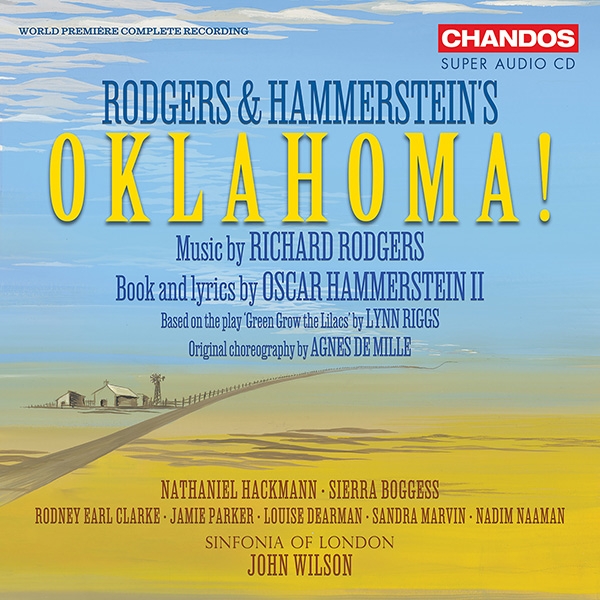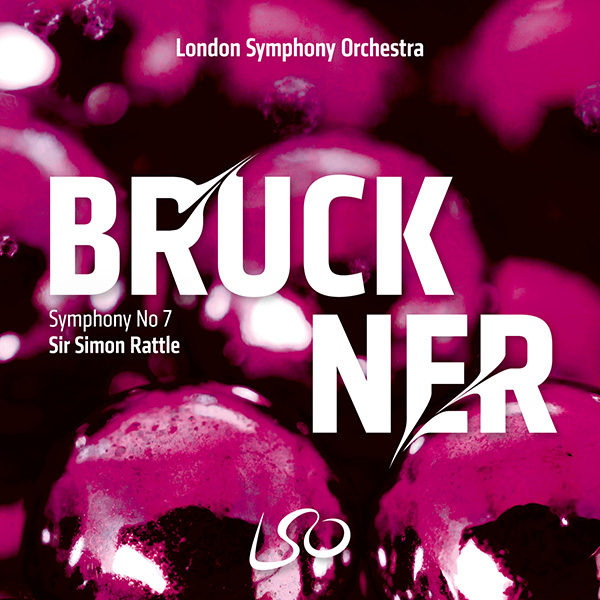| Columns Retired Columns & Blogs |
There often aren't many or any comments when the reviews for classical, jazz and pop are posted. I'm writing to let you know they are appreciated.

A complete recording of the music of Oklahoma!, the groundbreaking Broadway musical that determined the future of this distinctly American art form, deserves a strong welcome. But from the Sinfonia of London rather than an orchestra based in New York?
Before accusing it of inauthenticity, listen up. Not only is this the first recording of the complete score, including all the dialogue incorporated within vocal numbers; it also contains every delightful note in Robert Russell Bennett's original orchestrations. With an exceptional cast of singers whose Oklahoma accent is as believable as the story itself, Oklahoma! sounds as fresh as it must have sounded when it opened for an unprecedented five-year-plus run on the Great White Way.
Nathaniel Hackmann, previously the Broadway lead in Les Misérables, Jekyll and Hyde, and The Hunchback of Notre Dame, plays the lead role, Curly. An alum of San Francisco Opera's famed career-launching Merola Opera Program, he sounds totally at home in the Broadway idiom. Once he shifts from the forthright lyricism of "Oh, What a Beautiful Mornin'" to seductive softness in the reprise of "The Surrey with the Fringe on Top," you may find him superior to the original cast's Alfred Drake.
You'll be similarly hooked by the orchestral introduction to "Beautiful Mornin'," which sounds as though Richard Rodgers gained inspiration from the nature sounds of Richard Strauss's Alpine Symphony; by Curly's a cappella introduction, which was omitted from the original Broadway cast recording along with the essential intersong dialogue; and the range of colors produced by an orchestra of the same size and composition as the one first heard on Broadway 80 years ago. You'll even hear authentic instruments from the 1940s.
Simply wonderful.—Jason Victor Serinus

Postcards From Italy: Italian Music for Film
Marco Albonetti, saxophone; Roma Sinfonietta/Paolo Silvestri, cond.
Chandos 20291 (24/96 WAV). 2023. Marco Albonetti, prod.; Franco Patrignani, Davide Dell'amore, eng.
Performance ****½
Sonics ****
With the many earworm hits from Oklahoma! playing on repeat in my head, how could I resist another earworm recording, this one featuring great movie themes from Morricone, Rota, and others? Many elements make this recording so winning. Foremost are the melding of Marco Albonetti's warm, smoothly seductive soprano saxophone and the silken strings of the Roma Sinfonietta string orchestra. Also contributing are expert chamber orchestra arrangements and orchestrations by the Sinfonietta's conductor, Paolo Silvestri.
Then there's authenticity. Silvestri leads the orchestra that recorded many of Morricone's film scores the first time, and they also perform in the warm acoustic of Forum Studios, in Rome, where many of the great scores of Italian cinema were recorded. Piano interjections by Michelangelo Carbonara are another bonus in a recording that favors charm and warmth.
Morricone's themes from The Mission, The Legend of 1900, Nuovo Cinema Paradiso, Once Upon a Time in America, and Malèna are all warm, lovely, soothing, and tinged with nostalgia. Romantic to the core, they're simpler than "Amapola," a wonderful melody Morricone lifted from Joseph Lacalle for Sergio Leone's Once Upon a Time in America. Rota's music for Fellini's Amarcord and La Dolce Vita, as well as for Francis Ford Coppola's The Godfather, is less romantic, with "The Godfather Waltz" scoring points for its haunting darkness. Who can forget the circus elements and sadness of La Dolce Vita? I'm less convinced by Silvestri's repetitive "Theme from Controvento," and Gato Barbieri's theme from Bernardo Bertolucci's Last Tango in Paris reminds me once again of Morricone's special ability to soothe the soul and touch the heart.—Jason Victor Serinus

British Piano Concertos: Works by Jacob, Addison, and Rubbra
Simon Callaghan (piano), BBC National Orchestra of Wales/Stephen Bell, George Vass
Lyrita SRCD 416 (CD). 2023. Adrian Farmer, prod.; Andrew Smillie, eng.
Performance ****
Sonics ****
Three midcentury British concerti, unequivocally tonal, each composer using the idiom to different purposes. Gordon Jacob's concerto starts out bright and chipper, like one of the more congenial postwar symphonists, and maintains a playful mood even through some angular lines and thoughtful, rhapsodic episodes. The slow movement begins sparely, with woodwinds over sustained basses, eventually opening into a cautiously affirmative oboe solo and ambiguously spacious piano writing. A firm tread sets the finale's assertive tone.
At just 15 minutes, John Addison's score begins and ends in brooding introspection; the variations take in gently dissonant duets; broad, plangent cello and violin lines; and, briefly, a Hollywoodish sort of waltz.
From its brooding cor anglais opening, Edmund Rubbra's concerto registers as more substantial. The first movement's main Allegro goes with a hearty maritime swing, punctuated by aggressive outbursts. An unsettled minor section disrupts the spacious slow movement; the finale reverts to a proudly strutting Celtic jig.
Simon Callaghan's clean, lightweight piano sound, crisply articulate, is ideal for Jacob and Addison, who favor linear figurations over big, splashy chords. Callaghan is responsive to the varying moods, with many lovely moments. In the larger-scaled Rubbra, the quick, rippling scales are limpid, the quiet bits pensive. The conducting serves, although Vass lets a brief passage in Rubbra's finale come unstuck, and the final chord is oddly unemphatic.
Much of the time, the orchestra sounds pleasing but slightly recessed, even in the first of Rubbra's climaxes. Conversely, expressive reed and cello solos, and the pungent low-clarinet and bassoon attacks, emerge with an almost tangible presence.—Stephen Francis Vasta

Bruckner: Symphony 7
London Symphony Orchestra/Sir Simon Rattle (cond.)
LSO Live LSO0887 (CD). Andrew Cornall, prod.; Neil Hutchinson, eng.
Performance ****½
Sonics ****
Back in the '90s, this symphony was one of the best entries in the young Simon Rattle's somewhat checkered recording series for EMI. Fully a quarter-century later, he's improved upon it. His manner has become quicker and more flowing, shaving a full six minutes off his earlier timing, yet without sacrificing the required breadth or tonal weight. Rattle particularly excels at eliciting the mystery in the development sections. Quiet passages go with a wonderful hush—the Scherzo's recap is tenderly played—although some, like the start of the final coda, almost get lost. Rattle keeps a firm hand on the structures throughout, with no aimless wandering.
The warm, unified cellos at the start give way to clear, uplifting violins; the development is shaped with purpose—the alla breve stays within bounds—and the recap's "exotic" motif has a proud stride. The Adagio, mournful and grave, rises aspirationally; the second theme is dignified, like a court dance, though a swifter recap loses some of that. The Scherzo rolls along with lightness and drive, a less relentless juggernaut than some; its relaxed, singing Trio doesn't quite manage "rustic." In the forthright Finale, the walking basses could tread more firmly, though the vaulting trombone statements are suitably ominous.
The occasional iffy, frayed attack or smudged arrival still betrays Rattle's basically catch-as-catch-can technique. We hear some tentative ritards—the structural intent is laudable, the execution unsure. The LSO is otherwise in fine form.
The sonics are pleasing. The first tutti brings a hint of an edge, but the problem doesn't recur; conversely, massed brasses sound full and present, though without the expected depth. Woodwind and horn soli register nicely in the lighter passages, and we hear a good, deep maestro sniff to start the Adagio.—Stephen Francis Vasta

Tan Dun: Buddha Passion
Orchestre National de Lyon/Tan Dun, cond. Internationale Chorakademie
Decca 4854221 (5), 2 CDs (reviewed as 24/96). 2023. Tan Dun, prod.; Pan Bo, UUUStudio, Xiaoxing Lu, eng.
Performance *****
Sonics ****
Ever since I reviewed Tan Dun's six-act Buddha Passion in Seattle's Benaroya Hall in November 2022, I've eagerly anticipated this live recording. Its mammoth battery of Western and Eastern instruments and voices will test many systems.
The sound world of Buddha Passion is an exotic amalgam of East and West with a generous dollop of three-strip Technicolor Hollywood film score in the mix. Inspired by the two years Tan Dun spent researching the 750 Mogao caves and 2000+ well-preserved sculptures that miraculously survive in the Buddhist depository and UNESCO Heritage site in the Silk Road city of Dunhuang, Buddha Passion sprinkles a Chinese fable about selflessness and respect for all living things with a helping of echt-Christian shame and punishment. In addition to the large chorus, the work calls for a baritone (Shenyang), mezzo-soprano (Huiling Zhu), tenor (Chuanyue Wang), soprano (Sen Guo), indigenous female singer (Weiwei Tan), indigenous male singer/ Dunhuang xiqin player (Batubagen), Dunhuang fantan pipa player (Yining Chen), and percussion: Tibetan double cymbals, rubbed Chinese cymbals, and transparent paper cups in tubs of amplified water.
The work begins with sublime serenity, evoking the stillness of silent meditation. The music of Act V: "Heart Sutra" is free of artifice and filled with extraordinary sounds. At act's close, "The Sutra of Compassion" expresses a paradoxical message: "Form is emptiness; emptiness is form. ... All things ... are in essence emptiness." But "emptiness" cannot describe when every instrument under the sun joins with the vocalists to produce a sensual battering ram of spectacular sound. Special kudos to Shenyang, whose handsome voice recalls the greatest Broadway baritones on record. You've got to hear this.—Jason Victor Serinus

For this review set, I decided to veer off the beaten path. I'm glad to learn that the reviews speak to you.

Bruckner: Symphony 7 received four stars for sonic. But, if you liked the performance, please try Dolby Atmos H-Res version in Apple Music. Full five stars for my ears. The sound quality is amazing! We have to acknowledge the fact we live in an era where a streaming service usually offer better sound quality than a well mastered CD. Especially, Dolby Atmos on classical music are so wonderful!

these record recommendations are wonderful, highly welcomed & appreciated.
Thank you so much!
best regards
HB72